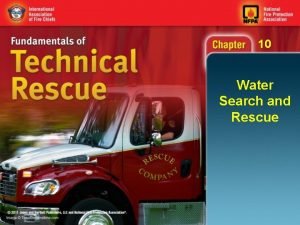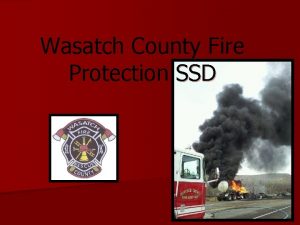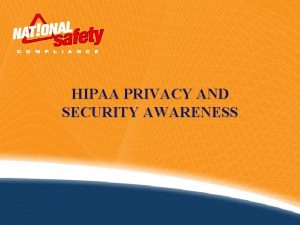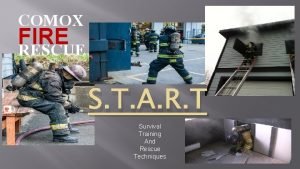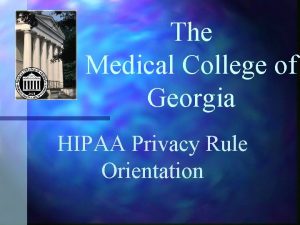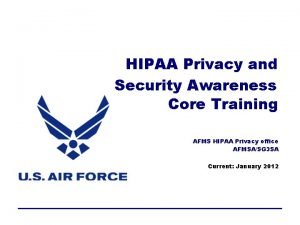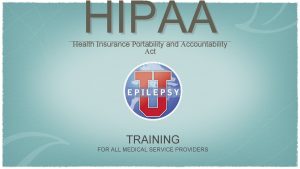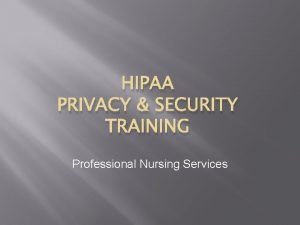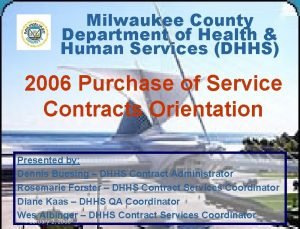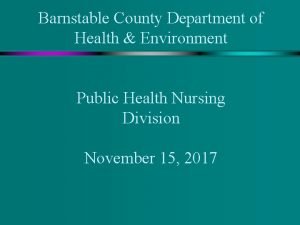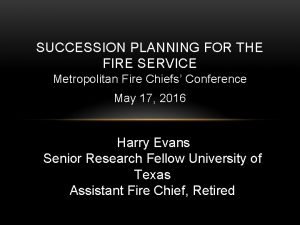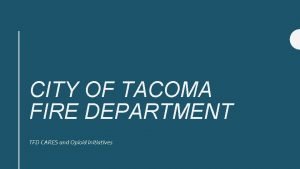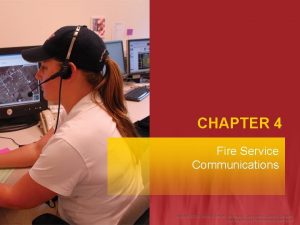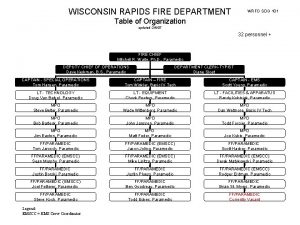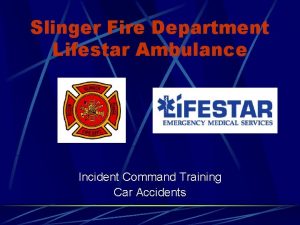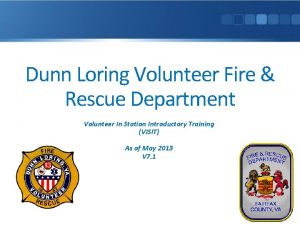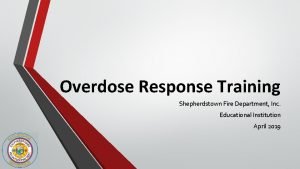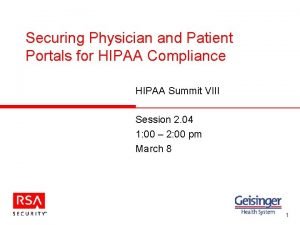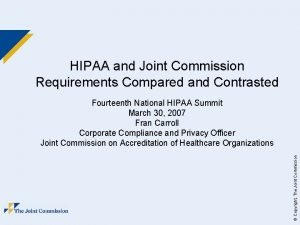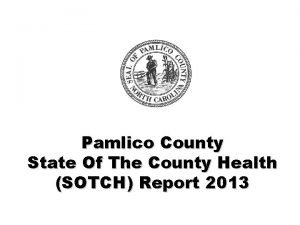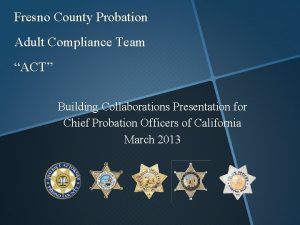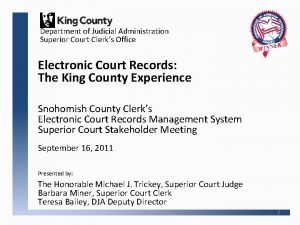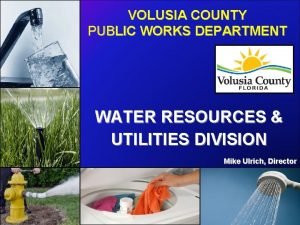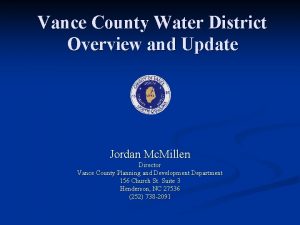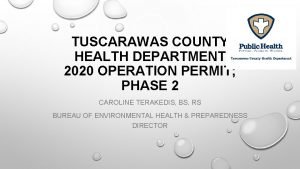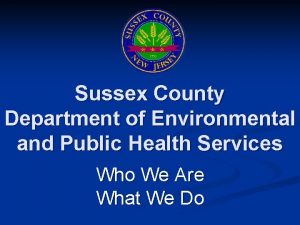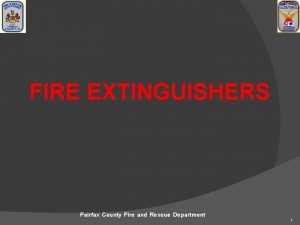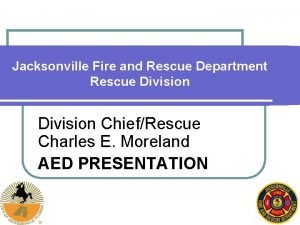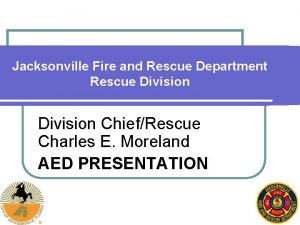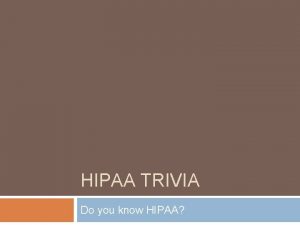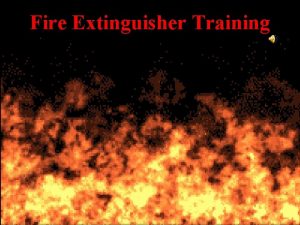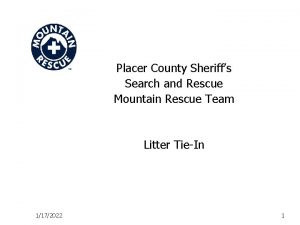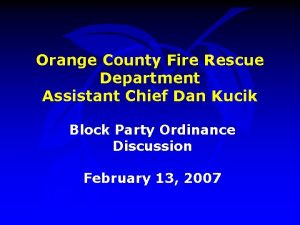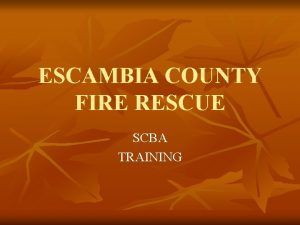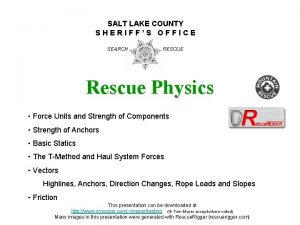HIPAA Training Frederick County Fire and Rescue Department




















































- Slides: 52

HIPAA Training Frederick County Fire and Rescue Department

What is HIPAA? ? �HIPAA = Health Insurance Portability and Accountability Act. Federal Law that was passed in 1996. �Created by – United States Department of Health and Human Services (DHHS)

Still not clear? ? �HIPAA is a common set of standards that protects certain health information. �There are several components – but, we are most concerned with the “Privacy Rule. ”

The Privacy Rule �The intent of the Privacy Rule is to provide basic rights regarding the use of “Protected Health Information” (PHI). �It protects all “individually identifiable health information. ” �Electronic, paper, or oral. �Applies to “covered entities. ”

Who is a Covered Entity? Three Categories: �Health plans. �Health care clearing houses. �Health care providers who transmit any health information electronically. FCFRD falls under the Health Care Provider category!

What’s Required? The Privacy Rule requires Covered Entities to: �Protect PHI. �Designate a Privacy Officer. �Look for “leaks” in the policy. �Conduct/document training for the ENTIRE Department. �Develop an Authorization Form for release of PHI.

FCFRD PHI Request form found on our website at www. fcfrd. com

More Requirements �Develop a Notice of Privacy Practices �When permitted, always disclose only the minimum necessary PHI �Update policies and procedures �Identify Business Associates and create contracts �Apply reasonable administrative, technical, and physical safeguards

Privacy Officer �An individual within the organization that is responsible for developing and implementing policies and procedures required by HIPAA. �Frederick County Fire and Rescue Department’s Privacy Officer is EMS Billing Manager Christine Bauserman.

Protected Health Information �PHI is any information created or received by a health care provider which relates to: �Past, present, or future physical or mental conditions. �Provision of health care. �Past, present, or future payment for care.

Examples of PHI � Name � Address � Date of Birth / Age � Social Security Number � Scene pictures that include license plates � Medical condition / past medical history � Full face photos

�HIPAA should NEVER negatively impact the quality of patient care or impede the ability to provide care!! �The appropriate communication of PHI with other health care providers directly involved in providing patient care does not constitute a violation of HIPAA. �Keep in mind Minimum Necessary! Broadcasting a patient’s communicable disease could be a violation. Instead of stating patient’s disease remind others to use universal precautions.

Safeguarding PHI �PCR’s should be kept in a secure location. �Always log out of your reporting software before walking away from your tablet or computer. �Networks containing PCR’s should be passwordprotected with user specific logins. �Generic logins allow for anonymous access to PHI and set up the Department for liability. �Include confidentiality statements on e-mails and faxes that contain PHI. �Never allow someone else to use your login information.

Use Caution… Beware of discussion of PHI, such as: � Talking about current or prior incident(s) while restocking ambulance or typing your report at the ER. � Discussing a call anywhere other than an official audit or review. � Discussing “interesting” calls, famous patients, or neighbors. � Sharing a co-worker or fellow responder’s PHI. � Posting of scene photos on social media. Remember even off duty the public sees you as a representative of the Fire and Rescue Department.

Selfies and EMS ‘Selfie war’ paramedic sentenced to 6 months in jail �Christopher Wimmer and another EMS paramedic, Kayla Dubois, were investigated and charged last year after allegations surfaced the pair had compromising photos on their phones of patients inside ambulances who were under their care as part of an ongoing “selfie war. ” �If a picture is need to show mechanism of injury than take it with your tablet/laptop. No pictures should ever be taken on your cell phone.

Calif. EMT sued after posting picture of patient’s injury By EMS 1 Staff WALNUT CREEK, Calif. — An EMT is facing a civil lawsuit after posting a photo of a patient’s serious injury online. Earlier this year, a 21 -year-old man, who identified himself as Keyano, had one of his legs amputated in a motorcycle crash that nearly killed him. The EMT that transported him to the hospital posted a graphic photo of Keyano’s leg on Instagram, captioned, “This is what happens when you’re careless in the rain on a motorcycle. ” The post also included the hashtags #byebyeankle and #thelouderyouscreamthefasterwego. The photo was deleted several days later, and the EMT wrote a public apology to Keyano and his family via social media, reported CBS San Francisco. “When you’re an EMT, don’t you abide by the laws and regulations? ” Keyano’s mother asked. “What were you thinking? ” Since the photo was taken inside a hospital by a medical provider, it is likely that privacy laws will come into play.

PPCR Copies �Who should get a copy of my patient’s PPCR? � Personnel not directly involved in patient care, QA, or billing are not permitted access to the patients PPCR. �For example: � If I transport in a ambulance from a different agency but no representatives from that agency rides on the call then they are not covered and can not obtain that patient’s PPCR.

Unsure About Discussing an Incident? ? Ask yourself… �Would a Judge agree that the disclosure benefited patient care AND was performed with the utmost discretion? ? ? �If you were the patient, would you want an “embarrassing” injury or illness to be discussed?

Notice of Privacy Practices (NPP) �The Department must make a Good Faith attempt to provide a NPP to each patient. �You are required by law to offer the NPP to each patient. You may also tell them it is available on our website. �They don’t have to take it but you have to offer it. �The Department must also make an effort to get a signed “Acknowledgement of Receipt. ”

Notice of Privacy Practices � Any department that charges for service needs to give a NPP to every patient that is transported, including a signature form which acknowledges receipt and permission to bill insurance on the patient’s behalf. � Every career and volunteer member of the Department must review and be familiar with this material. � An example can be viewed on the next two slides. � The NPP is also available on the internet at www. fcfrd. com.



NPP in Emergency Settings � During the emergency treatment of a patient, the NPP must be given as soon as practical as detailed in 45 CFR 164. 520 of the privacy rule. � Providers may provide this information after the transfer of patient care at the receiving facility. � This ensures that the provision of this information does not interfere with patient care or become lost during the emergent phase of treatment. If after transfer of care it is still not feasible to present the patient with the NPP, then the EMS Provider may leave it with the assigned nurse to present when it is feasible.

Permitted Disclosures Disclosure of PHI is acceptable in the following circumstances: � Treatment � Payment � Operations � Public Health Regulations � Victims of Abuse � Judicial Proceedings � Law Enforcement � Births and Deaths � Research � Protection of Public Safety

Treatment, Payment, and Operations �Treatment – giving PHI to other providers involved in patient care, such as the hospital. �Payment – receiving PHI from other providers, as necessary for billing. �Operations – audits, quality assurance assessments.

Public Health Activities �Disclosures to public health authorities, as authorized by State Law. �Also allows for notification of communicable diseases to EMS providers involved in an exposure.

Victims of Abuse, Neglect, and Domestic Violence The law requires (and HIPAA allows): �Reporting an “endangered adult” believed to be a victim of battery, neglect, or exploitation to Adult Protective Services or law enforcement. �Reporting a child that is believed to be a victim of abuse or neglect to the immediate supervisor, Child Protective Services, or law enforcement.

Judicial Proceedings Disclosure must only be made when a Judge or Grand Jury orders disclosure through a subpoena or warrant. **A private attorney does not have the authority to order a Fire Department provider to discuss a case. If contacted by an attorney, always contact the your county’s law office for advice before proceeding. **

Law Enforcement Disclosure of PHI to Law Enforcement is �Required by law. permitted when: �Ordered by a court. �Ordered by Administrative Subpoena.

Law Enforcement � When assisting the police to identify or locate a suspect, missing person, or witness, the provider may release: � Name / Address � Date / Place of Birth � Social Security # � Blood Type � Date / Time of Treatment � Distinguishing characteristics – height, weight, tattoos, scars, etc…

Law Enforcement Decedents n n n In the Commonwealth of Virginia local law enforcement is required to respond to any unattended death and will conduct an investigation. You may request Law Enforcement anytime you feel an attended death is “suspicious” in nature. You may release PHI to alert law enforcement of a patient’s death, IF the death may have resulted from criminal activity. You are not required to make a “legal conclusion” that the death resulted from a crime. Only a “suspicion” is required. Note: there is a general exception for releasing PHI to coroners and funeral directors for non crime-related deaths.

Law Enforcement As patient care advocates, EMS Providers should encourage law enforcement to gain information directly from the source, when possible.

Civil Penalties The U. S. Department of Health and Human Services may impose civil penalties on a covered entity for failure to comply with a Privacy Rule requirement. HIPAA Violation Minimum Penalty Maximum Penalty Unknowing $100 per violation, with an annual maximum of $25, 000 for repeat violations (Note: maximum that can be imposed by State Attorneys General regardless of the type of violation) $50, 000 per violation, with an annual maximum of $1. 5 million Reasonable Cause $1, 000 per violation, with an annual maximum of $100, 000 for repeat violations $50, 000 per violation, with an annual maximum of $1. 5 million Willful neglect but violation is corrected within the required time period $10, 000 per violation, with an annual maximum of $250, 000 for repeat violations $50, 000 per violation, with an annual maximum of $1. 5 million Willful neglect and is not corrected within required time period $50, 000 per violation, with an annual maximum of $1. 5 million

Criminal Penalties � A person who knowingly obtains or discloses individually identifiable health information in violation of HIPAA faces a fine of $50, 000 and up to one-year imprisonment. � The criminal penalties increase to $100, 000 and up to five years imprisonment if the wrongful conduct involves false pretenses, and to $250, 000 and up to ten years imprisonment if the wrongful conduct involves the intent to sell, transfer, or use individually identifiable health information for commercial advantage, personal gain, or malicious harm. � Criminal sanctions are enforced by the U. S. Department of Justice. ? Pub. L. 104 -191; 42 U. S. C. § 1320 d-6.

HIPAA Scenario One You and your partner respond for a neighbor who suffers from depression. You discover during your assessment that the patient has had suicidal thoughts. After the call, you are concerned that other First Responders in your community need to know the extent of the patient’s illness so they can watch for warning signs should the depression deepen. Can you share what you have learned with you fellow First Responders?

Answer �No, this is a breech of confidentiality.

HIPAA Scenario Two There is a call in your town. It involves the treatment of an entrapped farmer who subsequently dies from his injuries. You are concerned that a Critical Incident Stress Debriefing might lead to a violation of HIPAA. Should you be concerned? ?

Answer • No, a Critical Incident Stress Debriefing is held with only those providers involved in the call. The rules of CISM is that everything said at the debriefing is confidential.

HIPAA Scenario Three You are in charge of presenting a CE session for the monthly meeting of First Responders. You want to share some of the details of a recent call, but you are concerned you will be in violation of HIPAA because the patient is a resident in your town. Can you do case review as education? If so, what precautions should you take to protect the patient’

Answer �You can use the details of the call as education as long as you do not give out identifying information such as name, address, etc.

HIPAA Scenario Four The First Responders in your fire department routinely use a break room in the station to fill out their paperwork. The room is not secure. How can you ensure that confidentiality is not compromised? Can you work on paperwork while non-FRs are in the room?

Answer �If you are working on EMS First Responder paperwork, you need to be sure to put everything away when you are done. Do not leave call reports with confidential information on the table where anyone can pick it up. You can work on paperwork with non EMS personnel in the room, but do not share the information with them.

HIPAA Scenario 5 �You have just assisted with your first field delivery of a newborn. You are so excited you post it on Facebook with pictures from your cell phone. Can you do this and still comply with HIPAA?

Answer �No. Putting information about EMS calls on Facebook is a breech of confidentiality. Even if you use no names it would be very easy in a small community for people to figure out who the mother and child are.

Resources �http: //www. hhs. gov/ocr/privacy/hipaa/understandin g/index. html �http: //www. hhs. gov/ocr/privacy/hipaa/understandin g/training/index. html �http: //www. provena. org/usmc/body_ems. cfm? id=291

Documentation Update �With the constantly changing environment surrounding healthcare, our documentation has come to the forefront. �Globally we are going to a more patient centered system where all records from pre-hospital, specialty and rehab facilities are sharing their information in one patient file. �Our records need to be accurate and complete to provide our patient’s with the best overall care. �The following slides will review some common errors.

Documentation Update � Remember all calls start at dispatch…why where you called? � Paint a picture from start to finish. From dispatch to on scene to transferring care at the hospital. Include all details. � Like mom says “Use your words” � You are trained to use descriptive words like lateral, medial, superior, and inferior so use those. You also know the difference between a femur and a humerous. Use the proper terminology. When no one term fits use the best words to describe what you have seen. � All patient’s get an assessment so make sure you detail that assessment in your narrative. � The chief complaint is the main thing the patient is complaining of not what the nursing home staff say the labs said. � The primary impression your difference diagnosis not what you were dispatched for. � Mental Status: What is their mental status and is this normal for them. � Signature: Make sure you get the patient’s signature with ALL calls. Only get the staff to sign if the patient is medically or physically incapable.

Documentation Update �Back to basics: � Remember your tools like OPQRST and SAMPLE �Treatment � How did you treat your patient’s complaint? How did they respond? Why did you place the patient on O 2 or start and IV, what was the clinical reason? �Transport and Transfer of Care � How did the patient get on the cot? Walk, assisted, full lift? Why couldn’t they walk by themselves? � Who did you transfer your patient to and where?

Documentation Update � Your Image Trend Report � So you did an awesome narrative that has everything you did but…. You didn’t put anything under procedures and medications. When we run numbers for the department or grants we need that information to show we are doing as providers. This information must be entered for proper reporting not only by FCFRD but the state requires it as well. � Attachments �EKG: If you place the patient on the monitor you are required to include a copy of the strip. This is considered a part of the patient’s medical record. �Facesheet: You are also required to attach a facesheet whenever possible to each transport. This must be for the correct patient. Attaching a facesheet for the wrong patient is considered a potential HIPAA violation.

Documentation Update �If you receive a notice that your report needs attention you are required to respond to that request in a timely manner. Your officers will be following up on outstanding reports. �As always if you have a question or need help we are here to help! �You all are some of the best providers out there…so let’s show people how amazing you are!

Next Step �Complete the quiz on the FCFRD website and click submit. �You must score 70% to pass the training. �If you do not pass you will be allowed one retest.

 Objectives of search and rescue team
Objectives of search and rescue team Anne arundel county fire stations list
Anne arundel county fire stations list Wasatch county fire
Wasatch county fire Cvs privacy awareness training answers
Cvs privacy awareness training answers Hipaa privacy and security awareness training
Hipaa privacy and security awareness training Pierce county search and rescue
Pierce county search and rescue Comox fire department
Comox fire department Talbot county maryland frederick douglass
Talbot county maryland frederick douglass Hipaa training georgia
Hipaa training georgia Mtf hipaa privacy officer
Mtf hipaa privacy officer Accountable hipaa training
Accountable hipaa training Hipaa training strategies
Hipaa training strategies Hipaa training for nurses
Hipaa training for nurses Milwaukee county human services
Milwaukee county human services Barnstable county department of health and environment
Barnstable county department of health and environment Succession
Succession Fermilab fire department
Fermilab fire department Tfd cares
Tfd cares Leon valley fire department
Leon valley fire department A fire department communication center functions
A fire department communication center functions Wrfd fire department
Wrfd fire department Slinger fire department
Slinger fire department Tuba city fire department
Tuba city fire department Mwaa fire department
Mwaa fire department Dunn loring volunteer fire department
Dunn loring volunteer fire department Shorewood fire department
Shorewood fire department Kuwait fire department online
Kuwait fire department online Shepherdstown fire department
Shepherdstown fire department Central islip fire dept
Central islip fire dept Stockton fire department call volume
Stockton fire department call volume North vancouver city fire department
North vancouver city fire department Reichstag fire who was the fire starter
Reichstag fire who was the fire starter Damper interface panel
Damper interface panel Fire hose reel signage standards
Fire hose reel signage standards A-e rwi
A-e rwi Fire extinguisher parts
Fire extinguisher parts Frederick taylor and frank and lillian gilbreth
Frederick taylor and frank and lillian gilbreth Geisingerconnect
Geisingerconnect Joint commission hipaa
Joint commission hipaa Department of higher education and training
Department of higher education and training Department of labor and training
Department of labor and training Wakulla parks and rec
Wakulla parks and rec Sotch orange
Sotch orange Gloucester county health department nj
Gloucester county health department nj Fresno county adult probation
Fresno county adult probation King county department of judicial administration
King county department of judicial administration Cowlitz county health department
Cowlitz county health department Columbia county road department
Columbia county road department Volusia county utilities
Volusia county utilities Volusia county zoning codes
Volusia county zoning codes Vance county water
Vance county water Tuscarawas county health department
Tuscarawas county health department Sussex county board of health
Sussex county board of health
